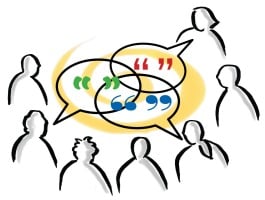Mike Pelfini — 15 February 2016
This past weekend you probably made sure that your sweet Valentine really understood your carefully crafted expressions of fondness, right? On the flip side, have you ever been in a conversation and sensed right away that you’d lost the other person? You know ~ her gaze shifts slightly from your eyes to whatever’s behind you; or his facial expression goes blank; or she fidgets impatiently? You’re sure you’re each speaking the same language, but somehow early on in the exchange, you must’ve switched to Vulcan!
A lot’s been written—scholarly and popular—about differences in communication styles between people based on gender, age group or otherwise. I’ve listed links to a few references at the end of this post.
Regardless the communication framework that best suits you, this much seems true: to have a conversation where the other person stays actively engaged with you, speak in the way that your listener needs to hear. This may or may not be in the way that’s most comfortable or natural to you.
In The Whole Brain Business Book recently updated by the author’s daughter Ann Herrmann-Nehdi, Ned Herrmann highlights the implications of our preferred modes of thinking to the ways in which we communicate. As it turns out, speaking with others in a Whole Brain® way dramatically improves the effectiveness of our communication efforts.
I’ve written about using a Whole Brain approach for helping people embrace changes in the workplace. Similarly, understanding and employing all quadrants of the Whole Brain Model is a great way to be sure that people “get” what you mean when you speak to them. And using the Communication Walk Around (Figure 1:1)[1] is a helpful tool for accomplishing this.
For example, when speaking with someone who tends to think rationally and uses data to make decisions (Blue, A Quadrant), make sure you get to your point early in the conversation. Speaking with facts, as opposed to using metaphors or analogies (Yellow, D Quadrant thinking), is also very important.
Someone who tends to think in concrete terms (Green, B Quadrant) will want to hear things in sequential order, and prefers specific details over generalizations.
Red, C Quadrant thinkers hear more readily when stories or examples are used—particularly if they can relate those stories/examples to their own feelings.
And D Quadrant thinkers will listen for the context of what is said, seeking to fit what they hear into the big picture in order to really understand.
Using a Whole Brain approach to communication—where people learn how to express themselves in ways that are true to their thinking style and sensitive to others’ styles—dramatically and quickly improves the chances of having conversations that work. You’ll find yourself not only speaking with colleagues in the same language, but also enjoying the twinkle of understanding in their eyes that says, “I get it!” much more frequently!
COMMUNICATION STYLE REFERENCES:
- The Whole Brain Business Book
- The Platinum Rule: Discover the Four Basic Business Personalities and How They Can Lead You to Success
- Communication styles: Understanding gender differences
- Men are From Mars, Women are From Venus
- Male and Female Communication: Styles, Patterns & Differences
- The Five Communication Styles
- Gender Communication Differences And Strategies
- Are We Talking the Same Language? How Communication Styles Can Affect Relationships
[1] Ned Herrmann and Ann Herrmann-Nehdi, The Whole Brain Business Book (New York: McGraw-Hill Education, 1996, 2015)\
Mike Pelfini is the leadership coach at ForeMeta Coaching, providing 1:1 and peer leadership coaching and training for CEOs, senior leaders and executive teams. Mike guides individuals and organizations across thresholds onto paths leading to deeper purpose, rediscovered relevance and greater sustainability…to maximum achievement.
Copyright ©️ 2024 by Mike Pelfini. All rights reserved.
ForeMeta offers breakthrough leadership coaching to develop CEO self-leadership and leading teams and organizations. We offer both individualized coaching or group coaching to help leaders and their people achieve greater success. If you would like to learn more about priority setting specific to your needs, please contact us.


